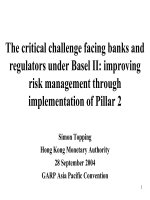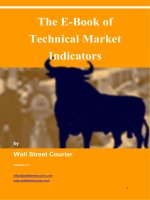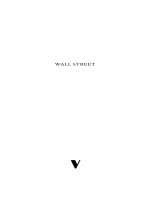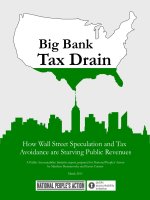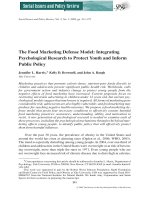Wall street, banks, and american foreign policy
Bạn đang xem bản rút gọn của tài liệu. Xem và tải ngay bản đầy đủ của tài liệu tại đây (18.09 MB, 107 trang )
W S, B,
A F P
W S, B,
A F P
S E
M N. R
W I
A G J R
First appeared in World Market Perspective (1984) and later
under the same title as a monograph produced by the
Center for Libertarian Studies (1995)
Ludwig
von Mie
Intitute
AUBURN, ALABAMA
Copyright © 2011 by the Ludwig von Mises Institute
Published under the Creative Commons Aribution License 3.0.
/>Ludwig von Mises Institute
518 West Magnolia Avenue
Auburn, Alabama 36832
mises.org
ISBN: 978-1-61016-192-3
Contents
Introduction to the 2011 Edition
vii
Introduction to the 1995 Edition
xxi
Wall Street, Banks, and American Foreign Policy
1
J. P. Morgan
3
An Aggressive Asian Policy
9
Teddy Roosevelt and the “Lone Nut”
13
Morgan, Wilson, and War
17
e Fortuitous Fed
25
e Round Table
29
e CFR
31
Roefeller, Morgan, and War
33
e Guatemalan Coup
43
JFK and the Establishment
47
LBJ and the Power Elite
51
Henry A. Kissinger
57
e Trilateral Commission
61
Bibliography
69
Index
71
v
Introduction to the 2011 Edition
By Anthony Gregory
e idea that corporate interests, banking elites and politicians
conspire to set U.S. policy is at once obvious and beyond the
pale. Everyone knows that the military-industrial complex is fat
and corrupt, that presidents bestow money and privilege on their
donors and favored businesses, that a revolving door connects
Wall Street and the White House, that economic motivations lurk
behind America’s wars. But to make too fine a point of this is
typically dismissed as unserious conspiracy theorizing, unworthy
of mainstream consideration.
We have seen this paradox at work in the aermath of the
2008 financial collapse. e le-liberals blame Wall Street and
Big Finance for betraying the masses out of predatory greed and
for being rewarded for their irresponsibility by Washington’s
bailouts. At the same time, the le appears reluctant to oppose
these bailouts outright, seeing the spending as a necessary evil
to return the global economy to stability, however inequitably.
What’s more, le-liberals fail to call out President Obama and
Democratic leaders for their undeniable hand in all this. ey
blame Goldman-Sachs but see their president, who got more campaign money from the firm than from almost any other source,
as a helpless victim of circumstance, rather than an energetic conspirator in corporate malfeasance on top of being the enthusiastic
vii
viii
WALL STREET, BANKS, AND AMERICAN FOREIGN POLICY
heir and expansionist of George W. Bush’s aggressive foreign
policy.
e Tea Party right is also hesitant to examine the corporate state too closely. ese conservatives detect an elitism in
Obama’s governance but are loath to earnestly challenge the
economic status quo, for it would lead to uncomfortable questions
about the warfare state, defense contractors, U.S. wars, the whole
history of the Republican Party, and all the typical rightwing
assumptions about the inherent fairness of America’s supposedly
“free enterprise” system. By refusing to admit that economic
fundamentals were unsound through the entirety of the Bush
years—by failing to acknowledge the imperial reality of U.S. wars
and their debilitating effect on the average household budget—
the right is forgoing its chance to delve beyond the surface in its
criticism of Obama’s reign.
Many on the right call Obama a “socialist” as many on the le
accused Bush of being a “fascist,” neither group seeing the stark
similarities in almost all of their policies. Meanwhile, the more
mainstream forces on both le and right refuse to countenance
such “extremist” rhetoric and insist that both political parties, for
all their differences, have the best of America’s interests at heart.
In the le’s unflinching loyalty to social democracy and economic
intervention and the right’s invincible love for the military and
support for corporate America we see why we are allowed to decry corruption and special interests, but not dig too much deeper
than that, lest we be relegated to the periphery of respectable
discussion.
Never afraid to slaughter sacred cows, Murray N. Rothbard
goes far beyond the mainstream lamentations in his trenchant
Wall Street, Banks, and American Foreign Policy. He analyzes over
a century of U.S. militarism and corporate cronyism, naming
names, sparing no one, and demonstrating the continuity of
imperialism regardless of the party in control, alongside the
many overlapping and competing business interests behind the
curtains. Rothbard’s account of the clash between the Morgans
INTRODUCTION TO THE 2011 EDITION
ix
and Rockefellers, who had some interests in common and some in
conflict, brilliantly hones in on the complexity of the story while
also explaining generally the dynamics of power. e discussion
of the “Cowboy” firms of the West (and their representatives
in Washington) vs. the “Yankee” Northeastern Establishment is
similarly illuminating: “While both groups favor the Cold War,
the Cowboys are more nationalistic, more hawkish, and less
inclined to worry about what our European allies are thinking. . . .
It should be clear that the name of the political party in power
is far less important than the particular regime’s financial and
banking connections.”
is fantastic wrien work is the definitive answer to many
naysayers—those who boast great differences between Republicans and Democrats; those who insist the main engine behind
U.S. wars is concern for national defense or human rights abroad;
those who dismiss “conspiracy theorizing” as oversimplified accusations of behind-the-scenes power-broking, devoid of nuance
and sophistication; and those who myopically think all major
decisions are made by the exact same clique of major players,
rather than through a complicated confluence of sundry interests
and forces.
Peddlers of oversimplified conspiracy theories will be uncomfortable with the level of detail in this book, as will the court
intellectuals who regard any and all references to the duplicity
of groups like the Council on Foreign Relations and the Trilateral
Commission as the talk of paranoids completely divorced from
reality. Furthermore, people who think that the elimination of
corporate influence from the public sphere will finally end the
wars and gra will be encouraged to rethink their assumptions
about the state: it is not, aer all, an organization for the public
good that has been hijacked by the rich and powerful, nor an
engine of corporate control that can be reformed toward liberal
ends. e state itself is and always will be the problem, and
so long as it has a military arm, it will be influenced by some
private interests or others toward opportunistic warring, and at
x
WALL STREET, BANKS, AND AMERICAN FOREIGN POLICY
a minimum manipulated by politicians, even the most supposedly
humanitarian and egalitarian of whom have a murderous and
diabolical record in deploying its forces and dropping its bombs.
Even large business interests can come and go, but the political
apparatus itself, the most inherently corrupting of all institutions
given its unavoidably coercive and monopolistic nature, will continue to inflict misery and loot the disadvantaged on behalf of the
powerful.
On the other hand, unlike moderate libertarians who regard
businessmen conspiring with government to be at worst mere
accessories to political crime made inevitable by the mixed economy, Rothbard does not temper his indictment of these junior
members of the public-private partnerships of imperialist plunder. Free will exists under the Rothbardian conception of both
political and economic theory, and if there’s blame to go around,
the bankers, lobbying CEOs, and saber-raling policy wonks deserve a considerable share along with the generals and presidents.
In many writings, Rothbard scrutinized the unseemly relations between policymakers and business interests. He championed a revival of libertarian class analysis, reclaiming the exercise
from the Marxists and leists who had transformed it from the
study of the tax-consuming political class against the taxpaying
subjects into a narrative of the dialectical struggle between producers and workers. Although Marx and his followers correctly
aacked the modern state for securing privileges for the most
influential business interests, the leist conception has turned
the classical liberal concept of class analysis on its head in its
advocacy of proletarian capture of the state apparatus and its
casting of producers and entrepreneurs as the inevitable enemies
of the common man. Nevertheless, leist scholars, particularly
of the New Le variety, have tended to “follow the money” in
their examination of government gra, corruption and war, a
task greatly appreciated by Rothbard and his fellow travelers.
In Wall Street, Banks, and American Foreign Policy, however,
the reader is treated to more nuance and detail as well as a more
INTRODUCTION TO THE 2011 EDITION
xi
coherent narrative than are common in the leist works. is is
because the theory behind Rothbard’s analysis, unlike the leist
theories, is sound. One general point bears this out. In failing to
grasp basic economics, the le falls for the military Keynesianism
that oen sees war as a blessing for the economy, if not in all other
ways. In January 2008, le-liberal economics guru Paul Krugman
(who had years earlier called for a Fed-induced housing bubble),
complained on his New York Times blog:
One thing I get asked fairly oen is whether the Iraq war
is responsible for our economic difficulties. e answer
(with slight qualifications) is no. . . . e fact is that war
is, in general, expansionary for the economy, at least in
the short run. World War II, remember, ended the Great
Depression.
Even the radicals sometimes mistake neo-mercantilist wars
as being in the interest of average American taxpayers—Noam
Chomsky has oen intoned that the American economy at large
relies on these wars—leading to an incomplete critique and a
flawed class analysis. is has guided the le in misconstruing
George W. Bush’s wars for oil as crude aempts to conquer oil
fields on behalf of U.S. consumers, rather than as efforts to benefit
some firms at the expense of others. (Also largely neglected, compared to the oil angle, were the possible monetary motivations
involved, as Iraq had begun pricing its oil in Euros in late 2000, in
defiance of American dollar supremacists.) Bad economic theory
also meant that when the George H. W. Bush’s Secretary of State,
James Baker, said the first Gulf War was about “jobs, jobs, jobs,”
the population was helpless but to take it at face value.
Flawed economic comprehension coincides with a poor reading of history. e le is still largely proud of its heritage in the
Progressive Era, when supposedly altruistic politicians stood up
for the common man against Big Business. Rothbard unravels this
fraud completely. e revered Teddy Roosevelt “had been a Morgan man from the beginning,” with family, business and political
xii
WALL STREET, BANKS, AND AMERICAN FOREIGN POLICY
ties to the banking giant. Roosevelt’s “first act aer the election
of 1900 was to throw a lavish dinner in honor of J.P. Morgan,”
and many of his policies, from the 1903 Panama coup to the trust
busting of Standard Oil, were huge blessings for Morgan interests.
e 1912 Progressive Bull Moose Party, far from being an aempt
to challenge the pro-business Ta administration for reasons of
egalitarian idealism, was also a Morgan plot. e winner of the
1912 election, Woodrow Wilson, far from aempting to rein in
the banks via the Federal Reserve Act, was a great champion of
the wealthiest of banking elites, especially the Morgans. e Fed
itself “enabled the banking system to inflate money and credit,
finance loans to the Allies, and float massive deficits once the U.S.
entered the war.”
More recently, the le-liberal criticisms of Bush suggested
that he had broken with an honorable American past in the way
he waged war—and in particular condemned his economic motivations as though they were something new or uniquely Republican. Very few critics saw Bush as following a tradition that goes
back at least to Franklin Roosevelt’s entry into World War II—
a war, Rothbard reminds us, the banking elites were pressing
for throughout the late 1930s. at war is still sanctified as a
testament to human altruism and a struggle of good against evil.
But World War II might also “be considered, from one point of
view, as a coalition war: the Morgans got their war in Europe, the
Rockefellers theirs in Asia.” Henry Stimson, the War Secretary,
had been a Wall Street lawyer with as many corporate ties as
any modern warmonger, and his assistant John J. McCloy, whom
Rothbard exposes for the particularly horrific policy decision of
Japanese Internment, went on to a lucrative career in the Rockefeller orbit with a side gig as chairman of the CFR for 17 years. If
the military-industrial complex did not exist beforehand, it was a
reality by the end of World War II. e ménage à trois among the
arms merchants, the U.S. war machine, and New York’s financial
powerhouses became fully consummated even before George W.
Bush was born.
INTRODUCTION TO THE 2011 EDITION
xiii
Beloved liberal presidents Truman, Kennedy, Johnson and
Carter all saturated their defense leadership posts with banking
elites. In particular, Rothbard shows that beginning with the
Kennedy administration an unseling influence on foreign policy was enjoyed by representatives from Lehman Brothers and
Goldman Sachs—firms whose nefarious impact is not lost on
Americans reading the financial news today. e cozy connection
between Lehman Brothers and the Pentagon was an especially
“fascinating aspect of the Johnson administration.” Lehman and
other major finance houses also dominated Carter’s top brass.
Somehow, the le generally regards these presidents as, at worst,
pushovers for corporate influence, rather than criminals guilty of
premeditated looting and warring on behalf of their cronies.
e financial collapse and bailouts are only the latest example of the near incoherence of the liberal critique. We are to
believe that the CEOs of major financial institutions are devoid
of compassion, the regulators are neglected heroes mysteriously
deprived of power since the Reagan years (although exactly how
this was done is never compellingly explained), and the president
is at worst a well-intentioned dupe. is formulation is partisan,
but even the anti-corporate criticism of Bush betrays a strange
faith in government itself, as it accused Bush of failing to “do
enough” and insisting on retrenching his own executive branch’s
power over the economy. All this even aer Sarbanes-Oxley and
Bush’s other major expansions of the regulatory state, far beyond
what happened under Bill Clinton.
Today’s wars, too, seem to confound the le-liberal who sees
corporate interests and conservative agitation behind all policy
failures. e war in Iraq, we were told, was a break with American traditions of diplomatic prudence. It is true that the neoconservatives represented an ideological school unusually bent
on democratization by force—hyper-Wilsonians, almost—who
indeed signified a shi from the “realist” school that had been
economically oriented around the Rockefellers that bestrode policy at least since World War II. For what it’s worth, much of the
xiv
WALL STREET, BANKS, AND AMERICAN FOREIGN POLICY
economic establishment was conspicuously more wary of the Iraq
war than most U.S. military adventures. is seems something of
an anomaly but there was a parallel situation in 1968, when, as
Rothbard tells it, even many of the “elite figures” of the Johnson
administration “had swung around to a firm opposition to the
war,” joined by much of the Establishment and Wall Street.
We can only dream of how Rothbard would have reacted
to the temporary triumph of the neocons over the realists in
Iraq. But needless to say, the general trajectory of U.S. foreign
policy—presidential wars of aggression, neo-mercantilism, Fedfinanced bombings, trade sanctions, exploiting the UN and NATO
when expedient—has been fairly consistent from the Progressive
Era to Obama, Bush’s aberration notwithstanding. And now the
U.S. is solidly back in the “realist” tradition with Obama, who is
using international coalitions to obscure the aggression against
Libya, and who is continuing the imperial project in Afghanistan
that originated with the meddling of Carter’s National Security
Adviser, Zbigniew Brzezinski, a practical paragon of the realist
school. More than a decade aer Rothbard wrote this book,
identifying Brzezinski as a Trilateral executive director and “recently selected director of the CFR,” this establishment poster boy
claimed credit for intentionally baiting the Soviets into invading
Afghanistan—a fateful intervention that has changed U.S. policy
in the Muslim world irreversibly.
When the le aacked the neocons over Iraq—echoing,
whether they knew it or not, critiques of neoconservatism that
can be traced to Rothbard and his Old-Right tradition—they did
not really understand what they were aacking. ey neglected
almost completely the lewing and particularly Trotskyite origins of neoconservatism, and tended to downplay the centrality
of Israel. ey somehow conflated a condemnation of Bush’s
“privatization” of war, his reliance on military contractors, and
his alleged desire to seize Arab oil, with their critique of neoconservatism, even though economics and corporate cronyism were
never major interests of this foreign-policy school.
INTRODUCTION TO THE 2011 EDITION
xv
is helps to explain the current confusion, for Obama has
greatly increased the presence of military contractors, expanded
the war in Afghanistan, bombed Pakistan, Yemen, Somalia, and
Libya, and seems generally on board with almost all of the Bush
program, including the withdrawal schedule in Iraq. Oil politics
and the planned construction of pipelines through Afghanistan
are still in the background. e economic and imperial interests
behind America’s response to 9/11 go far beyond the neocons and
their diversion in Iraq.
Of course, the war leaders of the supposedly anomalous Bush
years had been establishment luminaries for decades. National
Security Adviser and Secretary of State Condolezza Rice was on
the first Bush’s National Security Council and later served on
the board of Chevron. Vice President Dick Cheney (along with
Defense Secretary Donald Rumsfeld) had begun his rise under
Nixon. Cheney was a director of the Council on Foreign Relations in the late 1980s and, infamously, served in the late 1990s as
CEO and Chairman of the Board of Haliburton—the oil services
firm that was awarded significant contracts under Clinton during
his interventions in the Balkans, became a major beneficiary of
Bush’s war in Iraq (as well as constructing holding cells for the
prison camp at Guantánamo Bay), and still maintains such ties to
the empire.
Cheney, it might be noted, was also a member of the Trilateral
Commission—that elite club founded by David Rockefeller that
came to dominate the halls of power beginning in the Carter
administration. Writing in 1984, Rothbard concludes that regardless of the next election we could expect this organization
to be well represented. In addition to Cheney, Trilateral members who have risen or remained high in American government
since 1984 include Fed Chairman Alan Greenspan, George H. W.
Bush, his national security adviser Brent Scowcro, Bill and
Hillary Clinton, and Clinton cabinet members Lloyd Bentsen
(Treasury), Warren Christopher (State Department) and William
Cohen (Defense). Fewer Trilateral members have appeared more
xvi
WALL STREET, BANKS, AND AMERICAN FOREIGN POLICY
recently, although aside from Vice President Cheney they include
George W. Bush’s Treasury Secretary, Paul O’Neill, Obama’s
economic adviser, Paul Volker, and his foreign policy adviser
and ambassador to the United Nations, Susan Rice.
e corporate state’s continuities transcend partisanship. Ben
Bernanke, Bush’s economic adviser and later choice for Fed Chairman, was reappointed to this high seat by Obama. Another
holdover from the Bush years is Bush’s second Defense Secretary,
Robert Gates, whose checkered past includes urging Reagan to
sell weapons to Iran in 1985, heading the CIA under George
H. W. Bush, and serving on boards for such giants as Fidelity
Investments, NACCO Industries and Brinker International.
When Obama chose as Treasury Secretary the young Timothy Geithner the man was already a precocious fixture of the
establishment. He worked for Kissinger Associates in DC and
then joined the U.S. Treasury Department’s International Affairs
division in 1988. He went on to work for the U.S. embassy in
Tokyo, served as an assistant in monetary and financial policy
for years, always with an international focus, and became Under
Secretary of the Treasury for International Affairs in 1998. In
2002, he was a Senior Fellow in the International Economics department at the Council on Foreign Relations, while also serving
as director of the Policy Development and Review Department
at the International Monetary Fund. In late 2003, he became the
president of the Federal Reserve Bank of New York and then the
Vice Chairman of the Federal Open Market Commiee. In March
2008 he was intimately involved in the bailout and sale of Bear
Stearns. In the wake of the financial meltdown, Obama’s choice
of Geithner to head Treasury was surreally touted far and wide as
a pragmatic, responsible move. But even the minor appointments
demonstrate the irony of Obama’s reputation as a champion of
the common man against Big Business—the president’s pick of
General Electric CEO Jeffrey Immelt to oversee the effort to curb
unemployment rhymes nicely with FDR’s pick of GE CEO Gerard
Swope to head the National Recovery Administration.
INTRODUCTION TO THE 2011 EDITION
xvii
Of course, Obama himself is deeply in the pocket of the finance industry. Goldman Sachs accounted for over $994,000 of
Obama’s war chest. Lehman Brothers was the origin of $395,600,
a record amount for the company second only to what Hillary
Clinton received. Out of 20 of his biggest sources of campaign
money, eleven were investment banks or closely associated law
firms. Justin Raimondo noted in 2008 that Obama’s fat cat donors
included top executives from Wachovia, Washington Mutual, Citigroup, Deutsche Bank, Merrill Lynch, Bank of America, J. P. Morgan, Chase, Morgan Stanley and Countrywide.
Recent events demonstrate the pervasive denial of the banking
and foreign policy nexus. In February 2010, Congressman Ron
Paul caused a stir in the House of Representatives when, confronting Bernanke, he noted that “it has been reported in the past
that during the 1980s the Fed actually facilitated a $5.5 billion
dollar loan to Saddam Hussein, and then he bought weapons from
our military industrial complex.” Bernanke found the allegation
too absurd to warrant a serious response. Paul later cited University of Texas professor Robert D. Auerbach, author of the 2008
book Deception and Abuse at the Fed and professor at University of
Texas, to defend his statement. Whether or not Bernanke was sincere in his disbelief of this nefarious connection between the Fed
and U.S. diplomacy, many onlookers were similarly incredulous.
In March 2011, as the Obama administration was bombing
Libya, Senator Bernie Sanders wrote an open leer to Bernanke,
asking why the Fed provided 45 emergency loans at nearly zero
interest, totaling over $26 billion, to the central bank of Libya
from December 2007 to March 2010. He further asked why the
bank and its two New York branches were exempted from U.S.
sanctions on Libyan businesses.
Meanwhile, the media celebrated the supposed success of
TARP, the $700 billion bailout package passed at the tail end
of the George W. Bush presidency. At that time we had been
told it was necessary or else the financial collapse would swallow
the economy whole. Most Americans were skeptical, suspecting
xviii
WALL STREET, BANKS, AND AMERICAN FOREIGN POLICY
they were being robbed by the very forces responsible for the
crisis in the first place. e AP reported on March 30, 2011,
amidst the official vindication of TARP: “Some banks will use
money from a government program aimed at increasing small
business loans to repay their federal bailouts, according to the
Treasury Department official who oversees the bailout program.”
e headline was more concise: “Banks will use Fed funds to
repay Fed bailout.”
Since the publication of Wall Street, Banks, and American Foreign Policy a number of other works have emerged in the Rothbardian tradition of tracing the history of the central banking elite
and its warfare state conspirators. G. Edward Griffin’s extensive
book e Creature from Jekyll Island (1994), addressing economic
theory and history predating the material covered here by Rothbard, is particularly worth mentioning. Robert Higgs’s 2007 book
Depression War and Cold War examines the defense industry’s role
in World War II and the Cold War. For the definitive treatment on
World War I corporatism, with an emphasis on arms merchants
as well as the banks, see T. Hunt Tooley’s “Merants of Death
Revisited: Armaments, Bankers, and the First World War,” from
the Winter 2004 edition of the Journal of Libertarian Studies. It
includes a bibliography of many great references.
As for the issues of the 21st century, there are not many survey works on the connections between the war machine and the
banking establishment. John Perkins’s Confessions of an Economic
Hitman (2004) tells his story as an agent of international finance
with ties to the U.S. security state, convincing ird World nations
to accept crushing loans. William D. Hartung’s How Mu Are
You Making on the War Daddy? A i and Dirty Guide to War
Profiteering in the Bush Administration (2003) and Nick Turse’s
e Complex: How the Military Invades Our Everyday Lives (2008)
are decent treatments on military corporatism. On the financial
collapse and frauds, the investigative journalism of Ma Taibbi,
who writes in Rolling Stone with a focus on Goldman Sachs, has
culminated in his 2010 book Griopia: Bubble Maines, Vampire
INTRODUCTION TO THE 2011 EDITION
xix
Squids, and the Long Con at Is Breaking America. Finally, one
article in the Huffington Post deserves mention for daring to show
the relationship between the central bank and America’s court
intellectuals: Ryan Grim’s “Priceless: How e Federal Reserve
Bought e Economics Profession,” which appeared in October
2009.
What’s missing from most accounts of 21st century war and
banking, however, is a sound, Austro-libertarian class analysis
combined with a grasp of the business cycle, the meaning of human action in the military-industrial complex, and the inherently
predatory nature of the state. Joe Salerno’s 2006 work, “Praxeology and the Logic of Warmaking,” helps to set the theoretical
grounding that war, like all purposeful human activities, has an
economic logic to it and can be understood in terms of what its
perpetrators seek to gain. For an Austrian treatment of the housing crisis and the corruption in defense spending, Tom Woods’s
2011 book Rollba: Repealing Big Government Before the Coming
Fiscal Collapse provides some helpful chapters. Ron Paul’s End
the Fed has a section on inflation and war. Plenty of articles on
different facets of the imperial corporate state can be found on
Mises.org, LewRockwell.com, Antiwar.com and elsewhere.
But it would be great to see something like a sequel to Wall
Street, Banks, and American Foreign Policy, a comprehensive and
detailed but concise history starting where Rothbard le off during the Reagan administration and bringing us up to date for
today. Until then, we can be satisfied to read this wondrous work
of revisionist economic history, class analysis and antiwar journalism all packed into one. To understand modern America, the
banking masters and warmongers who’ve run the show for well
over a century must be exposed. To this day, no one has done it
as well as Rothbard.
Introduction to the 1995 Edition
By Justin Raimondo
Murray Rothbard’s 1984 analysis of modern American history
as a great power struggle between economic elites, between the
House of Morgan and the Rockefeller interests, culminates in the
following conclusion: “e financial power elite can sleep well
at night regardless of who wins in 1984.” By the time you get
there, the conclusion seems understated indeed, for what we have
here is a sweeping and compressed history of twentieth century
politics from a power elite point of view. It represents a small and
highly specialized sample of Rothbard’s vast historical knowledge
coming together with a lifetime devoted to methodological individualism in the social sciences. It appeared first in 1984, in the
thick of the Reagan years, in a small financial publication called
World Market Perspective. It was printed for a larger audience by
the Center for Libertarian Studies in 1995, and appeared online
for the first time in 2005.
eoreticians Le and Right are constantly referring to abstract “forces” when they examine and aempt to explain historical paerns. Applying the principle of methodological individualism—which aributes all human action to individual actors —
and the economic principles of the Austrian School, Rothbard
formulated a trenchant overview of the American elite and the
history of the modern era.
xxi
xxii
WALL STREET, BANKS, AND AMERICAN FOREIGN POLICY
Rothbard’s analysis flows, first, from the basic principles of
Austrian economics, particularly the Misesian analysis of banking
and the origin of the business cycle. is issue is also discussed
and elaborated on in one of his last books, e Case Against the Fed
(Mises Institute, 1995). Here, the author relates the history of how
the Federal Reserve System came to be foisted on the unsuspecting American people by a high-powered alliance of banking interests. Rothbard’s economic analysis is clear, concise, and wideranging, covering the nature of money, the genesis of government
paper money, the inherent instability (and essential fraudulence)
of fractional reserve banking, and the true causes of the business
cycle.
As Rothbard explains in his economic writings, the key is in
understanding that money is a commodity, like any other, and
thus subject to the laws of the market. A government-granted
monopoly in this, the very lifeblood of the economic system, is
a recipe for inflation, a debased currency—and the creation of a
permanent plutocracy whose power is virtually unlimited.
In the present essay, as in e Case Against the Fed, it is in the
section on the history of the movement to establish the Federal
Reserve System that the Rothbardian power elite analysis comes
into full and fascinating play. What is striking about this piece
is the plethora of details. Rothbard’s argument is so jam-packed
with facts detailing the social, economic, and familial connections
of the burgeoning Money Power, that we need to step back and
look at it in the light of Rothbardian theory, specifically Rothbard’s theory of class analysis.
Rothbard eagerly reclaimed the concept of class analysis from
the Marxists, who expropriated it from the French theorists of
laissez-faire. Marx authored a plagiarized, distorted, and vulgarized version of the theory based on the Ricardian labor theory
of value. Given this premise, he came up with a class analysis
piing workers against owners.
One of Rothbard’s many great contributions to the cause of
liberty was to restore the original theory, which pied the people
INTRODUCTION TO THE 1995 EDITION
xxiii
against the State. In the Rothbardian theory of class struggle,
the government, including its clients and enforcers, exploits and
enslaves the productive classes through taxation, regulation, and
perpetual war. Government is an incubus, a parasite, incapable
of producing anything in its own right, and instead feeds off the
vital energies and productive ability of the producers.
is is the first step of a fully-developed libertarian class analysis. Unfortunately, this is where the thought processes of all too
many alleged libertarians come to a grinding halt. It is enough,
for them, to know the State is the Enemy, as if it were an irreducible primary.
As William Pi put it in 1770, “ere is something behind the
throne greater than the king himself.” Blind to the real forces at
work on account of their methodological error, Le-libertarians
are content to live in a world of science fiction and utopian
schemes, in which they are no threat to the powers that be, and
are thus tolerated and at times even encouraged.
e Le-libertarian failure to take the analytical process one
step further is, in many cases, a failure of nerve. For it is clear,
given libertarian theory and the economic insights of the Austrian School, where the next step leads. No empirical evidence
is necessary, at this point (although that will come later, and in
spades); the truth can be deduced from pure theory, specifically
the Austrian theory of the nature of money and banking, and the
Misesian analysis of the origin of the business cycle.
is deduction was brilliantly and colorfully made in the first
issue of e Journal of Libertarian Studies (Winter 1977), by two
students of Rothbard, Walter E. Grinder and John Hagel III, in
“Toward a eory of State Capitalism: Ultimate Decision-Making
and Class Structure.”
While a pure free market would necessarily prevent the development of a banking monopoly, “the market system does concentrate entrepreneurial activity and decision-making within the
capital market because of the considerable benefits which are rendered by a certain degree of specialization.”
xxiv
WALL STREET, BANKS, AND AMERICAN FOREIGN POLICY
is “specialized capital market, by the very nature of its integrative role within the market system, will emerge as a strategic
locus of ultimate decision-making.” Given that some individuals will choose the political means over the economic, some of
these great fortunes will utilize their tremendous resources to
cartelize the market and insulate themselves against risk. e
temptation for bankers in particular to wield the power of the
State to their benefit is very great because it permits banks to
inflate their asset base systematically. e creation of assets made
possible by these measures to a great extent frees the banking institutions from the constraints imposed by the passive form of ultimate decision-making exercised by their depositors. It thereby
considerably strengthens the ultimate decision-making authority
held by banks vis-à-vis their depositors. e inflationary trends
resulting from the creation of assets tend to increase the ratio
of external financing to internal financing in large corporations
and, as a consequence, the ultimate decision-making power of
banking institutions increases over the activities of industrial corporations.
e Austrian insight focuses on the key role played by the
central banks in generating the distortion of market signals that
leads to periodic booms and busts, the dreaded business cycle
which is always blamed on the inherent contradictions of unfettered capitalism.
But in fact this capitalism is anything but unfeered. (Try
starting your own private bank!) e last thing American bankers
want is an unfeered banking system. Rothbard not only traces
the original market distortion that gives rise to the business cycle, but also identifies the source (and chief beneficiaries) of this
distortion. It was Mises who pointed out that government intervention in the economy invariably leads to yet more intervention
in order to “fix” the havoc wreaked—and there is a certain logic
in the fact that it was the original culprits who decided to “fix” the
distortions and disruptions caused by their policies with further
assaults on the market mechanism. As Grinder and Hagel put it:
